|
| |
Back to airliners
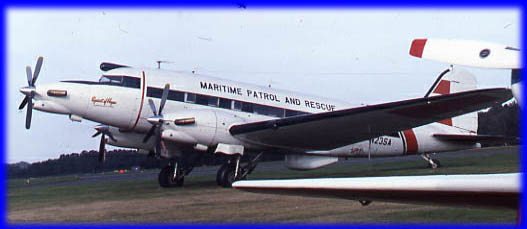
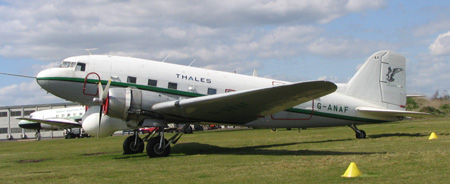 |
The Douglas DC3 (`Dakota') is undoubtedly the
most successful airliner of all time. 10,655 were built, the
majority as military transports during
the second world war. Carrying up to 27 people, it is small by
today's standards; but its rugged, reliable simplicity made it
suitable for operation almost anywhere. It first flew in December
1935. Dakotas are powered by two Pratt &
Whitney Twin Wasp radial engines. The top photograph shows a bizarre
conversion to three turboprop engines, the third being in the nose.
It illustrates the lengths people will go to to keep DC3s flying,
because there really isn't anything much better. The lower picture
shows a normally powered DC3 at Coventry in April 2006. |
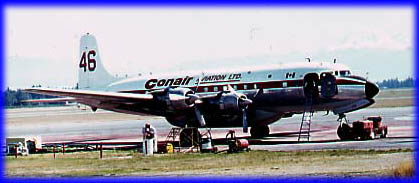
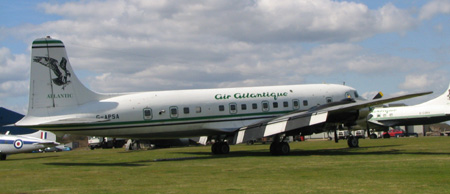 |
The Douglas DC6 was just too late to see
service in the second world war, first flying in February 1946. It
was essentially a stretched and pressurised version of the earlier
DC4. It was really a medium range airliner, carrying up to 92 people
over 2,800 miles (though it could go up to 5,000 miles with lower
payload). 461 were built, plus 165 as C-118s for the US Air Force &
Navy. Top: DC6 (C-GHLY) is operated as a
water-bomber by specialist firefighting company Conair, based at
Abbotsford, British Columbia, where it was pictured in September
1981. Lower: DC6 of Air Atlantique at Coventry, April 2006 |
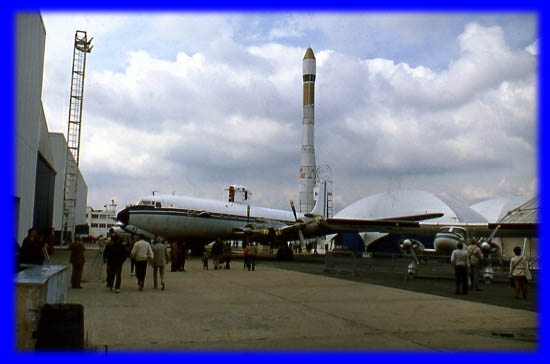 |
The Douglas DC7 was the stretched, long range
version of the DC6. It competed with the Lockheed Constellation to
be the standard intercontinental airliner until overtaken by the DC8
and Boeing 707 in the late 1950s. The DC7 first flew in May 1953,
and was powered by four massive Wright radial engines of 3,400
horsepower each.
Very few DC7s survive today out of the 338
which were built. This one, operated by the French air force, was
seen at Paris - Le Bourget in the early 1980s. |
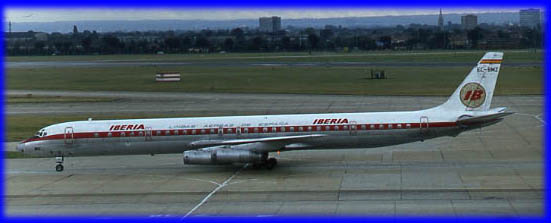
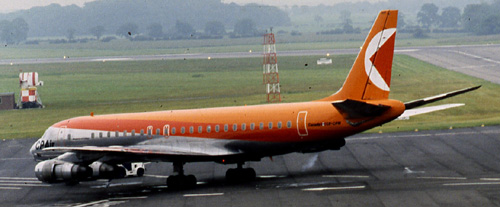 |
The Douglas DC8 was a direct competitor to
the Boeing 707. It first flew later, in May 1958, and stopped
production sooner; but not until 557 (almost exactly half the number
of 707s) had been built. Arguably, the DC8 was a more flexible
airframe; depending on the fuselage length, between 110 and 251
people could be carried! A small number of DCs entered US Air Force
service as C-24s. The ultimate DC8
stretch was the series 63, pictured here, which was just over 187
feet long. (Must have been hard to stop the tail hitting the ground
on take-off). This one, operated by the Spanish airline Iberia, was
seen at London Heathrow in august 1979. The lower picture shows a
short DC8 operated by Canadian Pacific visiting Newcastle, date
unknown |
|
|
The Douglas DC9 was conceived to fill the
short-haul market. It first flew in February 1965, predating its
main competitor (the Boeing 737) by some three years. Like the DC8
the airframe was very flexible, and exists in stretches from 104
feet (70 seats) to 148 feet (172 seats). 2,167 had been built by the
time production ceased in the late 1990s, including several for the
US Navy as C-9 Nightingales. The top
picture is a relatively short DC9-30 of Cebu Pacific, at Davao in
August 2005. The middle picture is a medium length DC9 series 50 of
Swissair, pictured at London
Heathrow in the late 1970s. The lower picture is an MD80, operated
by Far Eastern Air Transport and seen at Cebu in August 2005. |
 |
The Lockheed Constellation is one of my top
five favourite aircraft! It was conceived in 1939 as a
trans-continental airliner. Timing dictated that many of the early
aircraft were completed as military C-69 or C-121 aircraft for the
US Air Force, or R7Vs for the Navy. Range of up to 6,000 miles, up to 100 passengers
and speeds of up to 320mph made it a very impressive performer for
its day. More than 850 were built. Sadly, few survive. This example
is lovingly maintained in pristine condition in US Air Force
colours, and is seen at Cranfield, England in 1998. |
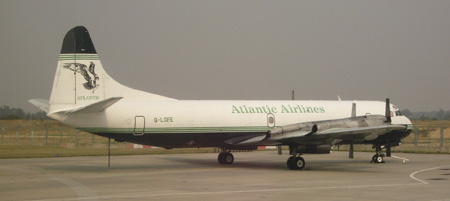
 |
The Lockheed Electra was a leading member of
the pack of 1950s four engined turboprops, in a similar class to the
(much less successful) British vanguard and the (much more
successful) Russian Ilyushin Il18. It first flew in December 1957.
Its four 3,700ho Allison 501 turboprops enable it to carry 104
passengers (or, latterly, 12 tons of freight) at 360mph for up to
4,400 miles. It is slightly unusual for a turboprop in being longer
(104 feet 6 inches) than its wing span (99 feet). However, a few
crashes in the 1960s, attributed to the impact of resonance at the
interface between the engines and wings, ensured production was
curtailed after only 170 had been built. The basic airframe was,
however, used for the military Orion, which continued in production
into the 1980s.
Top:
Stansted, September 2005. Lower: Coventry, April 2006 (formerly
owned by Reeve Aleutian airlines - `Reeve Illusion' is a joke). |
 |
The Lockheed TriStar first flew in November
1970 - three months later than its rival the DC10, despite having
been launched earlier. The delay was mainly due to problems with its
advanced engine, the Rolls-Royce RB211, which had incurred such vast
development costs that it drove Rolls-Royce bankrupt. The problems
were overcome, however. The aircraft in service is very reliable,
and the engine has since been developed and adopted by many other
designs. 250 were built before production ceased in 1983.
This TriStar of Omani operator GulfAir was seen
at Farnborough in September 1976. |
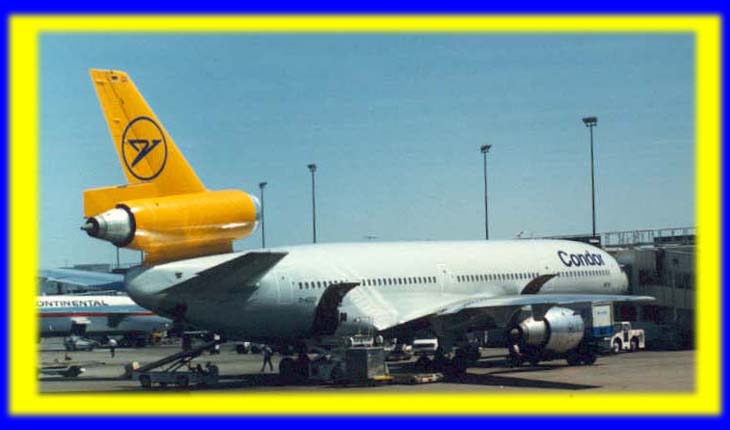 |
The McDonnell Douglas DC10 was developed by
the Douglas Aircraft division of McDonnell Douglas after the merger
of the two companies. It first flew in 1970 - one year after the
Boeing 747 and three months before the Lockheed TriStar. It
typically carries around 350 passengers and has genuine
intercontinental range of over 6,000 miles in some versions. After a
successful production run of 446 aircraft (including 60 KC-10s for
the USAF), it was superseded by the outwardly
similar MD11 in the 1980s. This example
is operated by Condor, the charter subsidiary of the German airline
Lufthansa, and is seen at Philadelphia in 1988. |
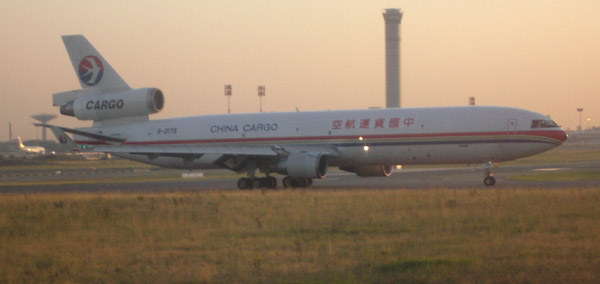 |
The McDonnell Douglas MD11 was a very
extensive redesign of the DC10. It first flew in January 1990, and
was for a time successful in keeping McDonnell Douglas in the
commercial airliner race against the increasingly dominant Boeing
and Airbus. Powered by three P&W4460 or GE CF6 engines, it can take
up to 410 people (in dense all-economy class seating) at 520mph for
up to 8,000 miles. It is 200 feet 10 inches long, with a wing span
(including the drag-reducing winglets) of 169 feet 6 inches. When
McDonnell Douglas merged with Boeing in the late 1990s, the
programme was kept running for a while, but reducing airline
interest led to its invevitable termination after 200 had been
built.
This one, operated by China Airlines as a
freighter, was at Charles de Gaulle, in July 2005 |





|